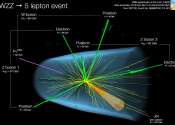ATLAS finds evidence of a rare Higgs boson decay
Since the discovery of the Higgs boson in 2012, scientists in the ATLAS and CMS collaborations at the Large Hadron Collider (LHC) have been hard at work characterizing its properties and hunting down the diverse ways in which ...









